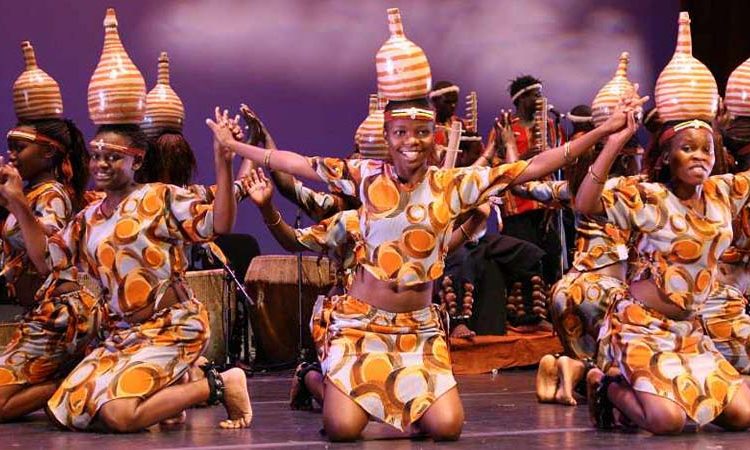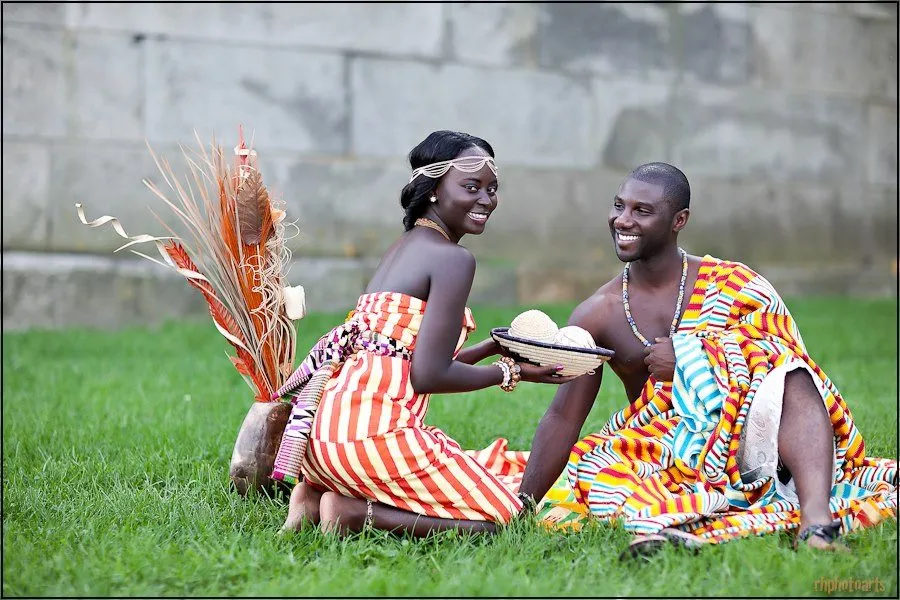Uganda’s Major Ethnic Groups And Population : The Top 10 Tribes : Wide linguistic ethnic categories can be distinguished among tribes in Uganda and their populations. The bulk of the population of the country speaks Bantu in the central, southern, and western regions, whereas non-Bantu-speaking populations live in the eastern, northern, and northwest regions. Ugandans, who come from a variety of ethnic groupings, speak more than 30 different African languages; English and Swahili are the official languages of the nation. The Baganda are the largest group and speak Luganda.

Tamenhaibunga, which emphasizes the value of friendship and love, is the primary dance form practiced here. ‘Good friends drink together and don’t argue for fear of breaking the gourd containing the wine,’ is how the term is translated. The people of the many tribes of Uganda dance in various way and Kiganda is a well-known dance in which participants move their lower bodies in time to the beat of the drum.
The majority of people prepare their own food and consume lunch and dinner twice daily. Porridge and a cup of tea are typical breakfast items. Women and girls cook the meals. Boys over the age of 12 and men are not allowed in the kitchen. Here is the list of the top 10 tribes in Uganda:
BAGANDA
Because of the major role played by their monarch, the Kabaka, in their political, social, and cultural institutions, Baganda tribes are known as Kings Men. A hierarchy of chiefs under the control of the Kabaka were in charge of levying taxes in the form of food and animals. Through the hierarchy, all of the shares are distributed, and taxes are ultimately paid to the Kabaka in his palace.
- The Baganda people live in Uganda, an African country, on the north and western coasts of Lake Victoria.
- Baganda presently controls the location of the old capital of Buganda. The Bunyoro Kingdom is to the south, while the Nile River is to the west.
- The largest tribe in Uganda is the Baganda. It makes up more than one-fourth of all the land in Uganda.
- Baganda’s local language is Luganda. Because Luganda is tonal, like other African languages, some words can be distinguished by pitch.
- With a population of almost 35 million, the Baganda are the most powerful tribe in Uganda.
- The majority of the population of Baganda is Christian, with some adhering to Catholicism and others to Protestantism. About 15% to 20% of the population are Muslims who practice Islam.
- Matooke, a plantain that is boiled, steamed, and served with groundnut, is the staple meal of Baganda. Eggs, fish, beans, groundnuts, cattle, poultry, goats, and, when in season, termites and grasshoppers, are among the few other edibles.
BANYANKOLE
Located in southwest Uganda, the Banyankole The king, Mugabe, ruled with absolute power. He claimed ownership of all the livestock in the nation. The number of cattle that each chief owned determined their position.
- A high-ranking caste of pastoralists and a lower-ranking caste of farmers make up Banyankole.
- The Bairu are farmers who also tend goats and sheep, whereas the Bahima are cow herders.
- Runyankole is a Bantu language spoken by the Banyankole. Prefixes, infixes, and suffixes are the modifiers used to form nouns in this language.
- The kids are taught good moral behavior through legends and stories. Men and women both excel in the verbal art of emphasizing proverbs and riddles.
- Themes from folklore include kingship, raising cattle, hunting, and other Banyankole issues.
- Christians make up the majority of the Banyankole, who observe Christian festivals including Christmas and Easter.
- Banyankole’s differences in clothes are based on rank and gender. Chiefs used to dress in lengthy cowskin robes. The average person carries a tiny piece of cowhide over their shoulders. Banyankole people today dress in contemporary western fashion.
- The herders of the Bahima tribe ingest milk, butter, and fresh blood from their animals. A highly important food is beef. Women and kids are the only ones who consume buttermilk. Men only eat cow and buffalo meat; children can eat rabbit.
BASOGA
Baganda’s neighbors to the east are the Basoga. They are situated in the current Kamuli, Jinja, and Iganga districts, which are situated between Lake Victoria and Lake Kioga. The Basoga were a fractured race. Even in the face of a common foe, they were unable to come together. This explains how they became continuously susceptible to outside influence, first from Bunyoro and then from Buganda.
- Busoga speaks a language called Lusoga, which is somewhat similar to Luganda.
- One of Uganda’s tribes, the Basoga, accounts for 8% of the country’s overall population.
- The Basoga held the idea that there was a spirit world. The Supreme Being was referred to as Lubaale.
- Each clan in Busoga had its own territory, which belonged to the clan head. No clan may transfer possession of the land to another clan.
BAKIGA
Southern Uganda and northern Rwanda are home to the Bakiga people. They go by the names Kiga or Chiga. The Bakiga people provide a wonderful illustration of a tribe that still adheres to many of its ancient customs. The Bakiga lived in clans, each of which had a leader who was not permitted to wed someone from another tribe.
- Rukiga is a Bantu language spoken by the Bakiga.
- The Bakiga take great pleasure in speaking a variety of languages and are highly welcoming.
- They had faith in Ruhanga, the all-powerful creator.
- The Nyabindi cult, which worships the ghost of a revered rainmaker, was significant.
- Bakiga had fewer animals than other pastoralist communities since they were primarily farmers.
- Sorghum, peas, millets, sweet potatoes, vegetables, and beans were all grown there.
- It is still regarded as polite for guests to eat with a family without being invited.
- The Bakiga have been making beer from sorghum and continue to do so.
The main instruments they use are:
- Omukuli [Flute]
- Amakondere [trumpets]
- Endingidi [Fiddle]
- Enanga [through zither]
- Engoma [Drums]
ITESO
According to Iteso tradition, they were originally from Sudan and, over many centuries, relocated to the south. They currently reside in the Amurai, Soroti, Kumi, Tororo, and Busia districts of the Teso-sub area. Travel to Uganda to experience the culture of the Uganda people.
- Finger millet and sorghum are there two main food crops.
- Women cultivate numerous wild edibles, like flying ants and mushrooms, as well as vegetables in the garden.
- Cattle herding by men and animal grazing were considered common rights up until the late 1960s.
- The Aturio age grading served as the framework for military organization.
- The army was known as the Ajore, and the war leaders went by the name Aruwok.
- The Iteso had three different birth types: single birth, twin birth, and spiritual birth. According to legend, spiritual birth took the form of air or water.
- The clan would perform an elaborate ceremonial ceremony to welcome the new child into the fold.
- The Iteso did not view death as a natural outcome. Witchcraft and ancestor spirits were blamed for death.
LANGI
The Langi people reside North of Lake Kyoga, in the Lango sub-region.
- Luo is the language of Langi.
- The rhino is the Langi tribe’s emblem.
- Before British domination, the Lango people had a government.
- Clan chiefs with the power to rule their clans were used to elect the Lango administration.
- Education in the pre-colonial era was both official and informal.
- Children were taught morality, manners, and how to treat their family and other people by their mother or siblings.
- Boys learned from their fathers or other male relatives.
- In the education of the Lango, games, myths, proverbs, and riddles all played significant roles.
- Some clans had inherited their chiefs.
ACHOLI
- The ethnic group known as the Acholi comes from south Sudan’s Agago, Amuru, Gulu, and Magwe districts. The Lua people, known as the Acholi, are thought to have migrated to northern Uganda from the region that is currently known as Bahr el Ghazal in South Sudan. It is mutually interpretable with Lango and other Luo languages. The Acholi language is a Western Nilotic language that is categorized as Luo.
- One of Uganda’s major tribes, the Acholi, has a population of around 2.0 million people.
- The ancient homes were high-peak, circular huts with a sleeping platform made of mud.
- They were adept hunters who used spears and nuts.
- They raised cattle, sheep, and goats.
- The natural birth and the Jok Anywala [godly] birth were two different birth rituals that the Acholi recognized.
- Acholi had faith in Jok, a Supreme Being. The Jok shrine was known as Abila.
- Although the Acholi sing about every situation, several of their songs mention well-known historical events.
BAGISU
The Bagisu are primarily found in Uganda’s Mbale district, which is situated near Mount Elgon. There is no history of an early migration among them. They claim that Mundu and Sera were the names of their ancestors.

- Male circumcision is the main and most distinctive social rite of the Bagisu.
- The Bagisu are feared for their might by their neighbors.
- Uncircumcised males are not permitted to wed Bagisu women.
- Massaba is the language they use.
- There were two or three clans in the Mbale area that made up the tribe.
LUGBARA
The Lugbara tribe is an ethnic group that predominately inhabits the Democratic Republic of the Congo and Uganda’s West Nile region. They are settled farmers who rely mainly on shifting-hoe farming for their livelihood.
- A significant bride price in cattle or iron equipment is required for marriage.
- Polygyny prevails.
- The majority of Lugbara continue to venerate their ancestors and revere the creator god Adroa.
- They are those who have been least impacted by Uganda’s modernization while still retaining a strong sense of self.
- The leopard is the Lugbara people’s national animal.
- They are the majority of guinea keepers in Uganda.
- Permanent subsistence farmers exist.
- The current traditional food is cassava.
- They cultivate a variety of root crops as well as millet, sorghum, legumes, and pigeon peas.
- Marriage is not permitted between clan members or between close relatives of the man’s or woman’s mother.
- A third of men have more than one woman, making polygyny a male ideal.
There are numerous language-speaking tribes in Uganda. There are more than 54 tribes in Uganda and roughly nine indigenous communities that have received official recognition. Uganda’s official language is English. The majority of the nation speaks Luganda and Swahili.


